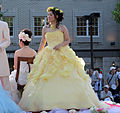Dress
This article has multiple issues. Please help improve it or discuss these issues on the talk page. (Learn how and when to remove these template messages)
|

A dress (also known as a frock or a gown) is a garment consisting of a skirt with an attached bodice (or a matching bodice giving the effect of a one-piece garment). In Western culture, dresses are more often worn by women and girls.
The hemlines of dresses vary depending on the whims of fashion and the modesty or personal taste of the wearer.[1]
History
19th century
Dresses increased dramatically to the hoopskirt and crinoline-supported styles of the 1860s; then fullness was draped and drawn to the back. Dresses had a "day" bodice with a high neckline and long sleeves, and an "evening" bodice with a low neckline (decollete) and very short sleeves.
Throughout this period, the length of fashionable dresses varied only slightly, between ankle-length and floor-sweeping.[1]
20th and 21st centuries
Beginning around 1915, hemlines for daytime dresses left the floor for good. For the next fifty years fashionable dresses became short (1920s), then long (1930s), then shorter (the War Years with their restrictions on fabric), then long (the "New Look").
Since the 1970s, no one dress type or length has dominated fashion for long, with short and ankle-length styles often appearing side-by-side in fashion magazines and catalogs. [2]
Usage

In most varieties of formal dress codes in Western cultures, a dress of an appropriate style is mandatory for women. They are also very popular for special occasions such as proms or weddings.[3] For such occasions they remain the de facto standard attire for most women.
Types
-
Ball gown, a very formal dress, typically elaborate and floor-length.
-
Bouffant gown, a fancy gown for formal occasions.
-
Cocktail dress, a semi-formal dress.
-
Débutante dress, a white dress worn by young women at debutante cotillions.
-
Evening gown, a long dress worn for evening events.
-
Frock dress, a dress worn by girls, generally ending above the knee.
-
House dress, an informal dress worn at home for doing housework in.
-
Jumper dress, a dress worn over a blouse.
-
Little black dress, an evening dress or cocktail dress, often quite short, which has enjoyed popularity as a wardrobe staple since the 1920s.
-
Maxi dress, a long dress, often ankle length, corresponding to the maxi skirt.
-
Micro dress, a very short dress with a hemline equivalent to that found on a micro skirt.
-
Midi dress, a dress of mid-calf length.
-
Mini dress, a short dress with a high hemline equivalent to that found on a mini skirt.
-
Nightdress, worn as nightwear, which may come in a variety of styles.
-
Princess dress, a fitted dress shaped by long shaped panels and seams rather than by darts.
-
Sailor dress, a dress with sailor collar and styling. Also known as a Peter Thomson dress.
-
Sari, a style of clothing worn by women in the Indian Subcontinent.
-
Sheath dress, a form fitting (or sheath-like) dress.
-
Shift dress or Chemise, a short, sleeveless dress in a simple style with little detailing
-
Shirtdress, a dress borrowing details from the style of a men's shirt, often including collar or front buttons
-
Slip dress, a dress closely resembling a petticoat.
-
Strapless dress, a dress with no visible means of support (usually held up by interior corsetry or boning, or by elasticated fabric.)
-
Sundress, intended for wearing in warmer weather. It will often be made of a lightweight fabric and will frequently be sleeveless.
-
Tea gown, a semiformal gown intended for wear during afternoon tea
-
Trapeze dress, an exaggerated A-line dress flaring from a fitted shoulder.
-
Wrap dress, a dress having a front closure which wraps around the body, forming a v-shaped neckline
-
Wedding dress-They are worn exclusively by the bride at her wedding. There are numerous styles of these and in Western cultures, white is the most popular colour.
-
Traditional Japanese kimono-style wedding dress
-
Bridal lehenga.
-
Traditional Bahrain wedding dress.
See also
|
|
References
- ^ a b Davis, Michael (2007). Art of dress designing (1st ed.). Delhi: Global Media. ISBN 81-904575-7-8.
- ^ changing hemlines
- ^ Pundir, Nirupama (2007). Fashion technology : today and tomorrow. New Delhi: Mittal Publications. ISBN 81-8324-203-0.
- Brockmamn, Helen L.: The Theory of Fashion Design, Wiley, 1965.
- Picken, Mary Brooks: The Fashion Dictionary, Funk and Wagnalls, 1957. (1973 edition ISBN 0-308-10052-2)
- Tozer, Jane, and Sarah Levitt: Fabric of Society: A Century of People and Their Clothes 1770–1870, Laura Ashley Ltd., 1983; ISBN 0-9508913-0-4






























